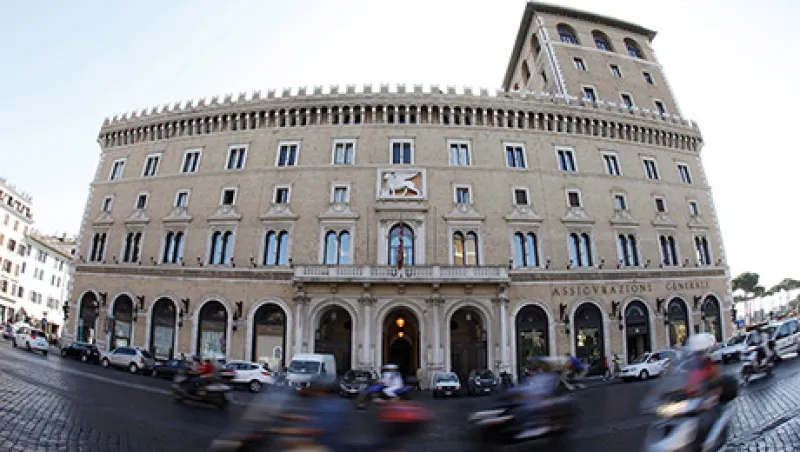Italy is not where you expect a fund manager to go to search for a strong, growing small-cap financial institution. Yet the London-based Baring International Small Cap Equity Fund found such an attractive Italian investment opportunity in Banca Generali. This Milan-based asset management firm has €33.6 billion ($42.2 billion) under investment, received a net inflow of €3.6 billion in the third quarter and earned a net profit of €132.4 million (see “Italy’s Banks Bolster Capital, Hope for an Economic Rebound”).
The returns offered by smaller companies like Banca Generali (market cap €2.44 billion) in developed nations outside North America has prompted U.S. and Canadian investors to add a net new allocation of €423.1 million in the third quarter to international small caps, according to eVestment, a data firm based in Marietta, Georgia.
Investors are moving into funds in this category both to diversify their allocations outside North America and to benefit from the superior long-term returns that small caps have historically achieved against returns for large caps, according to William Samuel Rocco, fund analyst at Morningstar. “Generally, the consensus is, Why limit yourself in this day and age? You just want a broader universe, rather than a narrower one,” says Rocco.
Nick Williams, head of the small- and midcap equity team at Barings, explains the opportunity found in Banca Generali, a subsidiary of Assicurazioni Generali in Trieste. Despite general squeamishness about Italy’s financial sector, according to Williams, the financial institution has been racking up assets because it “has rather proved itself as being a good operator and doesn’t have capital adequacy issues, and therefore looks to the Italian saver like a great place to put their money.”
Outside of Italy, Tokyo-based Nihon M&A Center, Japan’s largest M&A advisory firm, is another strong-performing Barings stock pick. Says Williams: “It’s a company that we think plays into an interesting theme in Japan in terms of aging of the peers in the small and medium enterprise sector.” A lot of the founders of companies in the 1960s and 1970s are looking to retire, and although they would like to pass on their company to an heir, because of Japan’s low birth rate, “it’s not always the case that their sons and daughters want to take over the business,” Williams explains. As a result, Nihon M&A Center faces a huge backlog of potential deals, according to Williams.
Barings’s stock picks have helped its international small-cap fund outshine its benchmark, the MSCI Europe, Australasia and Far East (EAFE) Small-Cap Growth Equity index. In the three years ending September 2014, eVestment numbers show returns for the Barings fund of 20.11 percent. That performance blew away the MSCI EAFE small-cap benchmark, which returned 14.49 percent. Although 2014 started off well for international small caps, steep declines in valuations in the third quarter led to a 2.74 percent decline for the first nine months of the year for the MSCI benchmark. Even so, the Barings fund outperformed with a smaller 0.66 decline over the same period.
Over the past four years, the EAFE small-cap growth funds have consistently outperformed the broader category for EAFE funds. If in November 2010 you were to have recalibrated both indexes to stand near 100, then the EAFE small-cap index would have risen to 122.54 on Nov. 13, 2014, whereas the broader EAFE index would stand at 112.96. Indeed the appeal of this class is that over the long term, small caps as a group tend to outperform large caps.
A single fund accounts for much of the new net flows into the EAFE small-cap growth category. The Schroder International Small Companies Fund had net inflows of $359.4 million in the third quarter, according to eVestment. This London-based fund had $4.26 billion in assets, making it the largest fund in the EAFE small-cap growth category. For the three years ending in September 2014, the Schroders fund returned 16.13 percent, according to eVestment, compared with 14.4 percent for the MSCI benchmark.
There were also significant new net flows of $70.7 million in the third quarter into the Oberweis International Opportunities Fund, based in Lisle, Illinois. The $645.2 million fund’s 30.22 percent return for the three years ending September crushed the 14.4 percent return of the MSCI benchmark.
EAFE small-cap growth fund managers can choose from an array of stocks to build a winning strategy. “There are 2,200 companies in the benchmark. That is by no means exhaustive of the whole opportunity set out there, because we don’t define our opportunities as the benchmark,” says Williams. Barings looks for companies with a good earnings growth track record. Selections must also be reasonably priced and thus mostly overlooked by other investors. “We like good-quality companies with a discount but with a surprise coming through,” explains Williams.
Get more on indexing and ETFs.






